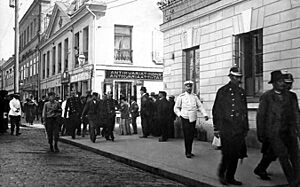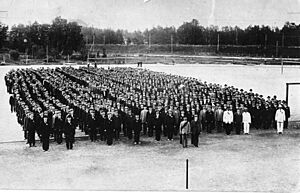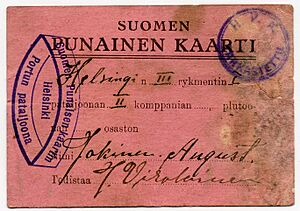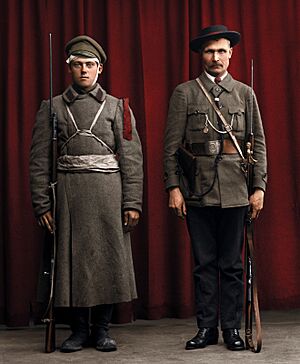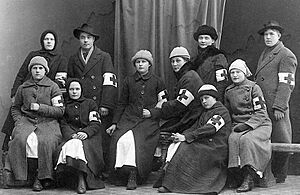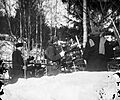Red Guards (Finland) facts for kids
Quick facts for kids
|
|
|---|---|
| Participant in the Russian Revolution of 1905 and Finnish Civil War | |
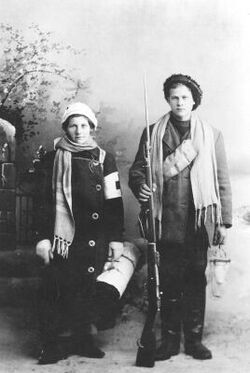
A Red Guard fighter (right) and a nurse (left) in 1918
|
|
| Active |
|
| Ideology | |
| Allegiance | |
| Leaders |
|
| Area of operations | Finland (FSWR), East Karelia |
| Allies | |
| Opponents |
|
| Battles and wars |
|
The Red Guards (Finnish: Punakaarti) were groups of armed workers in Finland during the early 1900s. They were like an army for the workers' movement. The Red Guards were a main group fighting in the Finnish Civil War in 1918.
These groups first started during a big strike in 1905. They were later stopped but came back in 1917 after the February Revolution in Russia. At the start of the Civil War, there were about 30,000 Red Guards. This number grew to 90,000 to 120,000 during the war. This included over 2,000 women in the Women's Guards.
The Red Guards were defeated in Finland by the Whites in May 1918. About 80,000 Red Guards were captured as prisoners. Sadly, 12,000 to 14,000 of them died in prison camps after the war. They died from sickness, not enough food, or being executed. Most Red Guards were later forgiven by the Finnish government in late 1918.
About 10,000 to 13,000 Red Guards went to Soviet Russia. Some of them fought against the Finnish Whites in the Russian Civil War. This included battles in northern Russia and the Estonian War of Independence. The Red Guards stopped being an organized group by 1920.
Contents
How the Red Guards Started
The 1905 General Strike
The Red Guards first appeared during a big strike in November 1905. This strike happened because people in Finland were unhappy with Russia's control. Workers and some political groups worked together. The strike lasted only a week. But by the end, different ideas caused a big split between the groups.
A group called the National Guard was set up to keep order. It also split into two sides. The Red Guards were for the working class. The Protection Corps was for the wealthier people. There were some small problems, especially in Helsinki, the capital. But big fights were avoided. Even after the strike ended, both groups stayed active. In 1906, there were about 25,000 Red Guard members.
Hakaniemi Riot and Sveaborg Rebellion
Fighting between the two sides finally broke out on August 2, 1906. This happened during the Sveaborg rebellion. Russian sailors who were Bolsheviks rebelled at the Sveaborg Fortress in Helsinki. The Helsinki Red Guard, led by Johan Kock, joined the rebellion. They caused trouble on the mainland.
On the last day of the rebellion, Johan Kock called for a general strike. He did this without permission from the Social Democratic Party. Thousands of Helsinki workers joined the strike. Wealthier people did not like the strike. They sent the Protection Corps to the Hakaniemi working-class area. Their goal was to keep the city's trams running.
At Hakaniemi Square, an angry crowd surrounded the Protection Corps. People started throwing stones. The situation turned into a gunfight between the Protection Corps and the Red Guards. Some Russian sailors also helped the Red Guards. Russian soldiers called cossacks finally stopped the riot. Two Red Guards and seven Protection Corps members died.
About 200 people were arrested. Only one Red Guard leader was found guilty because there was not enough proof against others. The funerals for the dead Red Guards became a large protest against violence from the wealthy. The Protection Corps also held a big funeral to protest against Red violence. After the Sveaborg rebellion was stopped, 900 Russian rebels and about 100 Red Guard members were arrested. 77 Red Guards were found guilty.
Why the Red Guards Were Stopped (for a while)
Because of the Hakaniemi riot, the Finnish government banned both the Red Guards and the Protection Corps. The Social Democratic Party had already decided to stop the Red Guards. This decision was made at a party meeting in Oulu in August. Some people disagreed with this choice. They had a secret meeting and created a hidden group to keep the Red Guards going.
This secret group was soon found out by the party leaders. But the hidden Red Guards stayed active until the 1907 election. Their job was to be ready for a possible revolution in Russia.
Red Guards Return in 1917
The February Revolution in Russia
The Red Guards started up again during the 1917 Russian Revolution. This happened because of disagreements over how to keep law and order. There was also a lot of confusion in Finland. After the February Revolution, the Russian police in Finland lost their power. Keeping order was first given to the Russian military. Then it was given to local worker groups. These new groups were not armed and did not plan a revolution.
Later, a new People's Militia was formed in March in 17 big Finnish towns. The political right side did not like this new plan. The government formed a group to solve the problem.
On July 18, a "power law" was passed by the Finnish parliament. The Social Democrats had a majority in parliament. This law would have moved law-making power from Russia to Finland. It would also have moved power from the government to the parliament. This law would have allowed a Social Democratic government to be formed. But the Russian government did not approve the law. They worked with Finnish parties to close the parliament.
In the October 1917 election, the Social Democratic Party lost its majority. But it was still the biggest party. The government then stopped the People's Militia. They created a new police force. People who supported workers or left-wing ideas were not allowed to join.
Workers' Order Guards Form
A lack of food caused many farm strikes in the summer of 1917. On July 13, a fight happened between striking farm workers and their bosses in Huittinen. This event is often seen as the start of the problems that led to the Civil War in 1918. After the Huittinen fight, wealthy farmers in the Satakunta area started forming Protection Guards. Other parts of the country soon followed.
The workers' movement responded by creating Workers' Order Guards. By early October, these guards were in 17 towns and 20 rural areas. Most were in industrial parts of Finland. These groups had up to 7,000–8,000 men. On October 20, the Finnish Trade Union Federation asked all local worker groups to form Workers' Order Guards.
In the next three weeks, the number of guards grew to 237 groups with over 30,000 members. The rules for the Guards were printed in worker newspapers. Their setup was like a military group. But instead of a single commander, they had a five-person committee.
Finland was now divided into two sides. The middle and upper classes, including rich farmers, were against the working class, poor farmers, and people without land. The first fights between the Protective Guards and the Workers' Order Guards happened during the general strike in November 1917. More workers kept joining the Order Guards. By the time the strike ended on November 20, there were 40,000–50,000 members. A newspaper writer named Ali Aaltonen, who had been a lieutenant in the Russian Army, became the first leader of the Workers' Order Guards.
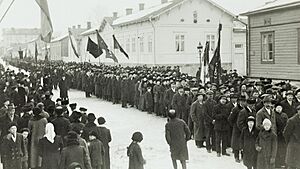
The general strike was the first time the Workers' Order Guards acted as a national group. In many places, they led the strike instead of the strike committees. The guards acted on their own. They looked for food and weapons in wealthy homes. The right-wing Protection Corps was weak. So, the Workers' Order Guards usually acted without problems. But in some places, the Protection Corps fought back. This led to violent clashes, showing that the Civil War was coming.
The Workers' Order Guards were strongest in Helsinki. They got weapons from Russian soldiers. The Helsinki Guard captured hundreds of people. They also took over the House of the Estates, which stopped the government from working. The leaders of the Social Democratic Party strongly criticized these actions. They insisted that the armed guards must be controlled by the party. Soon after the general strike, the first meeting of the Worker's Order Guards was held. It was in the Tampere Workers' Hall from December 16–18, 1917. New rules were made at this meeting. The guards were now fully under the control of the Social Democratic Party and the Trade Union Federation.
Moving Towards War
After Finland became independent from Russia on December 6, 1917, disagreements and unhappiness kept growing. Problems happened across the country. Striking workers and the Workers' Order Guards fought with the Protection Corps and wealthy people. Unemployed protesters surrounded the town hall for two days in Vyborg. In Tampere, the city council was taken over by the local Workers' Order Guard. In Turku, the Order Guard took over town offices and captured the police chief. The Protection Corps also attacked worker activists in some places.
On January 6, the Helsinki Workers' Order Guard said it was independent from the Social Democratic Party. This group was renamed the Helsinki Red Guard. Three days later, the guard took over the home of the Governor-General of Finland. It was then called the Smolna, like the Bolshevik headquarters in Russia. On the same day, the Helsinki Guard sent 200 men to Sipoo. They were looking for guns hidden by the local Protection Corps. This operation turned into a gunfight, and two Red Guards were killed.
At the start of 1918, the Workers' Order Guards had very few guns. For example, the biggest guard in Helsinki had only 20–30 military rifles. In early January, the leader, Ali Aaltonen, went to Russia. He wanted to get weapons from the Bolsheviks. On January 13, Aaltonen told his staff that 10,000 rifles and 10 cannons would arrive in Finland soon. At the same time, the Protection Corps was getting ready to receive 60,000 rifles from Germany.
By this time, many of the biggest Workers' Order Guards were led by extreme members. These members were pushing the Finnish workers' movement towards an armed fight. They were no longer under the control of the Social Democratic Party or the Trade Union Federation. To keep the workers' movement together, the party leaders had to talk with these revolutionary guards. Many top Social Democrats, like Väinö Tanner, Taavi Tainio, and Evert Huttunen, were moderate. They were against armed revolution and the actions of the Order Guards.
From January 19–23, violent clashes happened between the Workers' Order Guards and the Protection Corps. These took place in eastern Finland in Vyborg and Luumäki. They also happened in western Finland in Kiikka. In Vyborg, the Protection Corps tried to take control but was forced out of the city. Another serious event was in Luumäki. The Protection Corps took 200 rifles at the Taavetti railway station. Two days later, the Workers' Guards attacked the Protection Corps to get the guns back.
Finally, on January 25, the government declared the Protection Corps to be official government troops. The Social Democrats and the workers' movement saw this as a declaration of war against the working class. As a result, the Workers' Order Guards and the Helsinki Red Guard joined together. They became the Red Guard of Finland. The revolution was announced late on January 26. A red lantern was lit on the tower of the Helsinki Workers' Hall as a sign. The order to mobilize came the next morning from the Trade Union Federation. This happened at the same time as Red Guards and the Protection Corps started fighting on their own.
The 1918 Civil War
Red Guard Leaders
The first leader of the Red Guards was Ali Aaltonen. He was a former Russian Army lieutenant. He was chosen during the general strike in November 1917. When the Civil War began, Eero Haapalainen took over. Russian colonel Mikhail Svechnikov was his military advisor from late February. Haapalainen was removed on March 20. He was replaced by Eino Rahja, Adolf Taimi, and Evert Eloranta. This group of three stayed in charge until April 10. Then Kullervo Manner was given full power as head of the Red Government and the Red Guards.
August Wesley was the chief of the Red Guards' main staff from February 16 to April 6. On April 25, Manner fled to Soviet Russia. For the last ten days of the war, there was no main leader. The final big battle was fought in Vyborg. It was led by Edvard Gylling and Oskar Rantala.
How Many Red Guards?
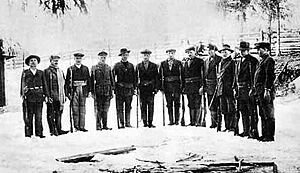
We don't know the exact number of people who served in the Red Guards. This is because records are missing or destroyed. Historians guess there were between 80,000 and 100,000 people. When the war started, there were about 40,000. But by the end of the war, the total number grew to 80,000–100,000 men and women. This included 2,600 female fighters. Thousands more women worked in unarmed support roles.
About 40,000 Red Guards were fighting at the front lines at any one time. The biggest single group was the Helsinki Red Guard. It had 8,000–10,000 men and women. Other large groups were the Red Guards of Tampere and Vyborg. The Saint Petersburg Finnish Red Guard was also important. The Female Guards had about 2,000–2,600 members.
Not many Russians joined the Red Guards. Even though 40,000 Russian soldiers were still in Finland. Only a few hundred joined, including a few dozen officers. Most Russian troops just wanted to leave Finland and go home. Besides the troops in Finland, the Bolsheviks in Russia helped the Reds in some battles.
How the Red Guards Were Organized
The Red Guards were made up of factory workers, farm workers without land, and tenant farmers. Most of them were members of the Finnish Trade Union Federation. Very few middle-class people joined. The average age was between 20 and 30. The youngest fighters were only 15 or 16 years old.
The Red military groups had infantry (foot soldiers), artillery (cannons), and a small cavalry unit (soldiers on horseback). Weapons and other gear mostly came from Russian troops. In early February, a train led by Jukka Rahja arrived from Russia. It carried 15,000 rifles, machine guns, cannons, and 2 million bullets. The Red leader Ali Aaltonen had bought these from the Bolsheviks. The Reds also had six armored trains and a few airplanes. Russian pilots flew the planes.
The main staff was in Helsinki. Other important staffs were in Tampere and Vyborg. The foot soldiers were divided into regiments and battalions. But in reality, the biggest groups they commanded were companies. A Red Guard company usually had men from the same trade union. For example, the Helsinki Red Guard had groups of shoemakers, tailors, blacksmiths, and so on. Some workers' sports clubs also formed their own teams. In the countryside, groups were made up of men from the same local area.
Red Guard fighters got a salary. Sometimes it was even more than they earned at their normal jobs. Many people were unemployed, so money was a reason to join. Very few Red Guards had any military training before. Those who had served in the Russian Imperial Army were usually chosen as company leaders. Red Guard fighters had a short military training before going to the front.
Battles were often fought like a normal workday. Fighting started at dawn. When the sun set, the men went back to their base. On the Tavastia Front, some troops even spent nights in Tampere. They would return to the front by train in the morning.
The Red Guards had big problems. They lacked equipment, had poor leaders, and not enough training. There were also food shortages at the front. Leaders were chosen by vote, which made discipline weak. Sometimes, this meant fighters did not want to attack or fight outside their local areas. The Red Guards did not have a clear command structure. Local leaders made their own plans. These plans did not always match what the main staff in Helsinki wanted. Since there were very few trained officers, battle plans had to be kept simple.
The War Itself
When the war started on January 27, the Red Guards took over Helsinki. They also took control of the biggest towns in southern Finland, where many factories were. A front line was soon set up. It stretched from the Gulf of Bothnia to the Karelian Isthmus. This line was 30–50 kilometers north of cities like Pori, Tampere, Lahti, Lappeenranta, and Vyborg.
The Whites took over rural northern Finland. The few Red strongholds there fell in less than two weeks. There was not much resistance. The last Red-controlled town in the north was Varkaus. The Whites took it on February 21. In other northern areas, most Red Guards were captured. But in Lapland, many managed to escape to Sweden, Norway, or Soviet Russia.
The Red military operations were in three main areas. These were the Western Front, the Middle Front, and the Eastern Front. The area north of Tampere was often called the Northern Front. The Red Guard main staff worked in Helsinki. Other important staffs were in Tampere and Vyborg. Lahti was also an important town for the Red military because it was a major railway hub. Many units were organized and trained there before being sent to the eastern fronts.
The Reds launched three big attacks. These were in early February, on February 21, and on March 10. Their goal was to take the east-west railways. These railways connected Ostrobothnia, Savonia, and Karelia. From there, the Reds could attack the strongest White areas and their capital, Vaasa. However, these attacks failed. The front line stayed in the same place from early February to mid-March.
On March 15, the Whites launched their main attack against the Reds in northern Häme. The Red front there collapsed in a few days. The Whites were then able to surround Tampere. Tampere was the most important Red town for military reasons. The Battle of Tampere was fought from March 23 to April 6. It was the fier fiercest battle of the Finnish Civil War. At the time, it was also the biggest city battle in the world. The Battle of Tampere ended with many surrendering Red Guards being executed. 10,000–11,000 were captured. Thousands more fled the surrounding areas.
At the same time, German troops landed on the south coast of Finland. They started their campaign to help the Whites. On April 6, the Red Government and the Red Guard main staff left Helsinki for Vyborg. Red units in the western areas were told to retreat to eastern Finland. The plan was to regroup the troops behind the Kymijoki river. But this plan never happened. Instead, the order caused many people to flee. Tens of thousands of Red Guard fighters, their families, and other Red supporters ran towards the east.
When the Germans took Helsinki on April 13, up to 8,000 local Red Guards surrendered. Thousands of others from the Uusimaa area joined the fleeing group coming from the west. In two weeks, over 100,000 Red refugees headed east. They wanted to escape to Soviet Russia. About 12,000 managed to cross the border. Most of the rest were captured. In late April, up to 30,000 civilians and Red fighters were caught by German and White troops in Lahti. The captured people were first put in the Fellman camp. Then they were moved to different prison camps across southern Finland. Most women and children were released. But 200–600 Red women were executed. Hundreds of others were moved to other prison camps.
The last major battle happened in Vyborg. The Whites took it on April 29. The last Red stronghold was in the Kymenlaakso area. The Reds there finally surrendered to the Germans on May 6.
Between March 23 and April 18, some fights also happened in remote eastern Lapland. A Karelian nationalist named Iivo Ahava was fighting against the Whites. The Whites had launched an expedition to take Russian White Karelia for Finland. Ahava formed a Red Guard unit in the Russian town of Kandalaksha. This unit was made of Red Guards who had fled from Lapland. Two other Finnish Red Guards were formed in Knyazhaya Guba and Kem. By mid-March, these units had up to 2,500 men. Ahava managed to stop the Whites. He also wanted to attack them from behind in northern Finland. However, the Red leaders were not interested in helping him. They believed the war would be decided in the populated areas of the south.
What Happened After the War
Many Finnish Red Guards managed to escape into Russian-controlled areas after the Whites won in Finland. Many of those who fled to Russia were put into new fighting groups. They fought in the Russian Civil War and, as a result, in World War I. The United Kingdom created the Murmansk Legion from Red Guard refugees. This was part of the North Russia Intervention by the Allies. The British hoped to use the Murmansk Legion to fight off the German-allied White Finns. These White Finns were trying to take East Karelia.
Red Guard units also served in the 7th Red Army. They fought in the Estonian War of Independence. There, the Finnish Reds fought against Finnish White volunteers. These volunteers were fighting for the Republic of Estonia.
See also
- Female Red Guards of the Finnish Civil War
- Finnish Socialist Workers' Republic
- Red Guard's March
Images for kids


